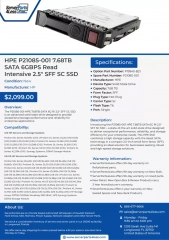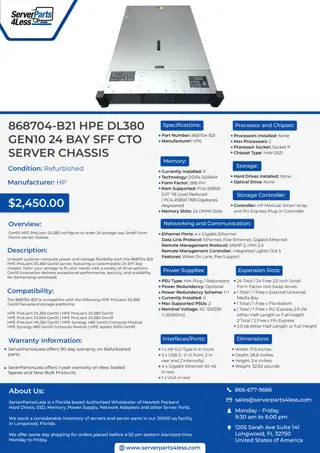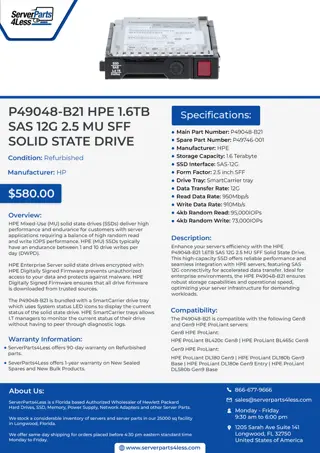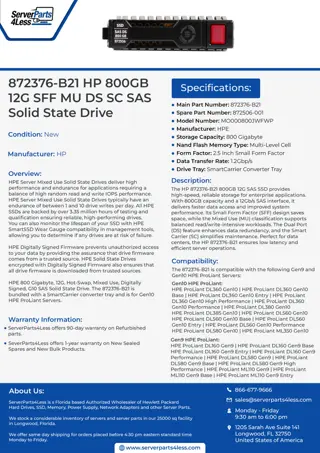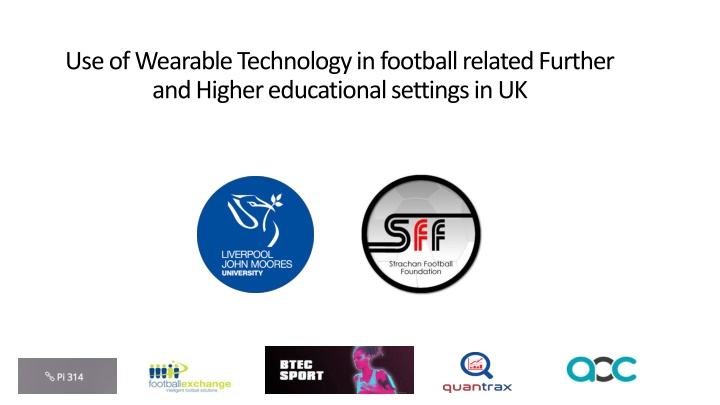
Exploring Wearable Technology in Football Education Settings
Dive into the use of wearable technology in football education in the UK, focusing on further and higher educational settings. Discover how sports industry support, graduate contributions, and the evolving landscape are impacting learning outcomes and industry needs. Uncover the reasons for research in this area and the goals to enhance student experiences and industry knowledge.
Download Presentation

Please find below an Image/Link to download the presentation.
The content on the website is provided AS IS for your information and personal use only. It may not be sold, licensed, or shared on other websites without obtaining consent from the author. If you encounter any issues during the download, it is possible that the publisher has removed the file from their server.
You are allowed to download the files provided on this website for personal or commercial use, subject to the condition that they are used lawfully. All files are the property of their respective owners.
The content on the website is provided AS IS for your information and personal use only. It may not be sold, licensed, or shared on other websites without obtaining consent from the author.
E N D
Presentation Transcript
Use of Wearable Technology in football related Further and Higher educational settings in UK
Sports industry Support in the UK Sports industry Support in the UK Sport & Exercise Science graduates added 3.9 billion to the economy 0.3%GDP Estimated social and public purse benefits 7.8 billion Around 71% are employed in directly related occupations 6 months after graduation 96% stay in UK Every 1 student invests in SES yields 5.50 in future earnings Estimated 15,000 SES graduates each year ill equipped to work in industry Transferable skills Need to put bit in here about FE and HE
The changing Landscape Now Video Assisted Referee 2012 Sport science From 1880s to 1996 a stalwart at the side of the pitch the Trainer Since then qualified physiotherapist HPC registered <1996 the magic sponge EVOLUTION The most adaptive to change sport industry is always moving and changing, making it essential for learners to have the drive and resilience to adapt. Sport science In football contribute to increased performance and reducing risk of injury (loss due to injury cost clubs est 41MM England premier league 2019) 0.01% become professional players in the UK
Why is the research needed? Further developing qualifications pathway, Industry needs (employment), FE & HE learning and teaching landscape changing (COVID-19, T - Levels), Technology advances, GDPR, Lack of knowledge surrounding use in FE & HE settings Research An Investigation into the use of wearable technology in Football in Further Education (FE) settings in United Kingdom Aims The primary aims of the Research is to examine the current use of wearable technology in football related FE and HE settings, in order to develop a model, for the use of wearable technology in football related FE & HE environments. Studies 1. Identify the extent, type and approach to the use of wearable technology in football related education programmes in FE and he settings. 2. Describe and contrast the use of wearable technology in football elite performance and FE related settings. 3. To plan and design strategies and construct an effective model, to improve effectiveness of use of wearable technology, specifically communication and feedback mechanisms in football related FE settings. 4. To deploy and evaluate a model, in the use of wearable technology in football related FE settings. Outcomes To Map the landscape of use in FE and HE Construct an model for use within the FE and HE settings to enable increase in knowledge and better understanding of wearable technology uses in education and industry Thus enhance and expand student learning experience and better inform to benefit the sports and education industries
Main qualifications pathway in FE settings Apprenticeship BTEC Sport Aim to provide an individualised learning experience with end-point assessment 4 brand new (end of 2019) suites of BTEC Level 3 Nationals developed in collaboration with NGBs and Industry mapped to industry standards, allowing for direct access to employment in some instances Sport, Fitness and Personal Training Sports Coaching and Development Sport and Outdoor Activities Sporting Excellence and Performance Reformed qualification Internally assessed Industry specific and attract UCAS points 2 year project Observation Portfolio of evidence Reflective journal Apprentice showcase Assessment plans will identify one of four approaches to external quality assurance: Institute for Apprenticeships Ofqual Professional Body-led model Employer-led model Models are emerging There are other related qualifications that offer a blended approach such as the two examples shown
New Apprenticeship Sporting Excellence Professional (SEP) However, assessment plans may describe the gateway differently. One size does not fit all (individualised longitudinal learning journey) College-university-graduate employment (transferable skills cross curriculum use) Creating a seamless transition (no big paper folders) Optimising what they enjoy and relate to (mobile devices, technology) Level 3 qualification The employer should be confident that the apprentice will pass their end-point assessment Observation Portfolio of evidence Reflective journal Apprentice showcase
New BTEC Sport qualifications New BTEC Sport qualifications 4 brand new suites of BTEC Level 3 Nationals for the sport sector: 1) Sport, Fitness and Personal Training 2) Sports Coaching and Development 3) Sport and Outdoor Activities 4) Sporting Excellence and Performance Reformed qualification after 10 years Are internally assessed Help prepare learners for work but also attract UCAS points supporting progression to HE Wearable technology complements all 4 Where can wearable technology directly fit? Core unit & optional units examples being: Unit E the core research project, using the technology will give quantifiable data and scientifically underpin any project this being a 2 year unit on all courses. In more detail the example of Unit 6 - sporting injuries. technology allows for monitoring and highlighting imbalances, over training and undertraining, Each suite contains different sizes - so there will be 14 qualifications in total.
SFF Courses and pathways SFF Courses and pathways NCFE- Project based learning approach No exams, all coursework based Closely related/aligned to BTEC Individual within a team environment Linking the sport to the lesson Continuous ongoing assessment from lecturer Specific historical pathways include Academia with University, USA scholarship (playing and degree) Industry direct employment, Football, Fitness, Leisure health and wellbeing, Business start ups, self employed e.g personal trainer/ lifeskills coach.
SFF Specific units of work in year 1 SFF Specific units of work in year 1 NCFE project based learning approach Internal ongoing assessments of coursework no exams Sports coaching module 3(5) Preparing for a career in sport and physical activity module 2(14) Practical team sports module 4 (8) Training and programming module 15(7) Assessing risk In sport (includes injuries) module 12(3) (n) = indicates module in BTEC that is aligned to based on pre 2019 BTEC for Sports
SFF study August 2020 SFF study August 2020 - - December 2020 December 2020 Observations at SFF. August-September 2020 Monitor and evaluate current working practices 1-1 interviews educators/coaches/players/support staff pilot study October-December 2020 pre pilot assessment (understanding staff and students) Presentation & orientation Deployment of wearable technology 3 week observation of individual use of WT Evaluation
New Apprenticeship Sporting Excellence Professional (SEP) Level 3 qualification More individualised approach to learning Examples of end-point assessment methods Observation Portfolio of evidence Reflective journal Apprentice showcase Assessment plans will identify one of four approaches to external quality assurance: Institute for Apprenticeships Ofqual Professional Body-led model Employer-led model Models are emerging
Sporting Excellence and Performance Sporting Excellence and Performance 3 qualifications and pathways BTEC Level 3 National Extended Certificate in Sporting Excellence and Performance BTEC Level 3 National Diploma in Sporting Excellence and Performance BTEC Level 3 National Extended Diploma in Sporting Excellence and Performance Where does wearable technology directly fit? Core unit C3 professional sport performer, In football wearable technology is used commonly daily it is estimated that over 98.5% of professional players now use E research project, in line with (1) having exposure to wearable technology and software for analysis will enable students to quantify their project and underpin with scientific rationale. Optional Example 15- ethical and current issues in sport, this is an area that is new and therefore very current, added to this the use everyday with gathering all physiological and biophysical data and with advances in the technology there are ethical issues to consider and debate.
Sports Coaching and Development Sports Coaching and Development Sports Coaching and Development 4 qualifications and pathways BTEC Level 3 National Extended Certificate in Sports Coaching BTEC Level 3 National Foundation Diploma in Sports Coaching and Development BTEC Level 3 National Diploma in Sports Coaching and Development BTEC Level 3 National Extended Diploma in Sports Coaching and Development Where does wearable technology directly fit? Core unit Unit E the core research project, using the technology will give quantifiable data and scientifically underpin any project that uses Unit E is a 2 year unit on all courses Optional Unit Example being 6 - sporting injuries technology allows for monitoring and highlighting imbalances, over training and undertraining, Total Unit A,B,D1,1,2,4,6,8,9,10,12,13
Sport development, wearable technology continues to grow at a exponential rate in the football and sport industry being the top trend for the last 3 years, this sector continues to be part of everyday life 8- fitness testing either stand alone or as in professional sport with the use of wearable technology then every training session becomes a test. 9- fitness training, by recording what doing for every session allows for periodisation of training and enables user to follow and quantify what doing 10- tech tact skills in sport, positional requirements based on formation and tactical play prior to and during in match play 12- practical sports application, something that is now the norm in all professional teams in Europe, in the UK alone all top 4 leagues every team has exposure to the technology 13-influence of technology in sport and physical activity, this is bringing cutting edge tech to the college environment Indirectly?

